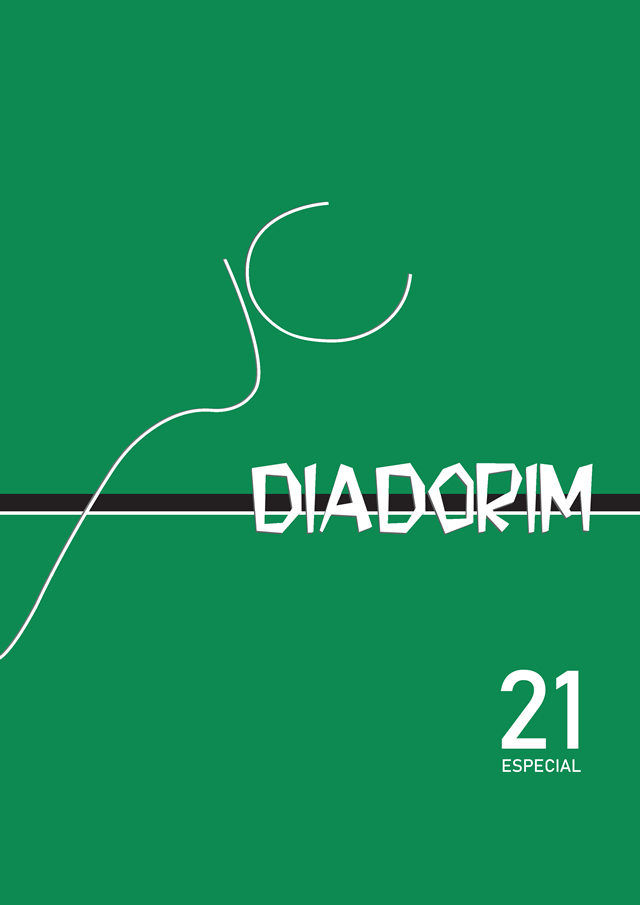A casa cai: unveiling geographies of exclusion and violence
DOI:
https://doi.org/10.35520/diadorim.2019.v21nEspa28330Palavras-chave:
urban space, favelas, gentrification, memory, military regimeResumo
Favelas have existed for more than a century and have been historically portrayed as spaces of violence, criminality, and poverty. Over the years there have been different efforts to eliminate them from the wealthiest parts of the city. In spite of the different policies to remove them, the presence of favelas persists in areas close to wealth neighborhoods such as Copacabana, Ipanema and Leblon. In 2014, Marcelo Backes published the novel A casa cai. The book tells the story of a former seminarist who leaves the priesthood after his father’s death. While investigating documents from his father’s safe, he realizes that part of his family’s fortune was made from real estate investments at the place where it used to be the Favela da Praia do Pinto. Drawing from David Harvey’s discussion on neoliberalism and urban space and Neil Smith’s notion of gentrification, the essay explores the ways in which the novel engages with questions of urban policies, displacement, violence, and memory. In so doing, it attempts to unveil the close association between capital, favela eradication programs and issues of inequality and discrimination. I argue that the novel is part of a larger debate over the struggle between social justice and the reproduction of capital. I also contend that Backes’s novel is part of a revisionist project that attempts to bring other facets to the military dictatorship in Brazil.
Downloads
Referências
BACKES, M. A casa cai. Rio de Janeiro: Companhia das Letras, 2014.
BEZERRA, K. C. Postcards from Rio: favelas and the contested geographies of citizenship. New York: Fordham University Press, 2017.
BRANDÃO, Z. Urban planning in Rio de Janeiro: a critical review of the urban design practice in the twentieth century. City and Time, 2006, p.37-50. Disponível em: < http://ceci-br.org/novo/revista/docs2006/CT-2006-53.pdf>. Acesso em: 22 de agosto de 2019.
BRUM, M. Favelas e remocionismo ontem e hoje: da ditadura de 1964 aos grandes eventos. O Social em Questão, v.11, n.29, p.179-208, 2013.
“Censo demográfico 2010: Aglomerados subnormais”. Brazilian Institute of Geography and Statistic, dez. 2011. Disponível em: < http://www.ibge.gov.br/home/estatistica/populacao/censo2010/aglomerados_subnormais_informacoes_territoriais/default_informacoes_territoriais.shtm>. Acesso em: 10 dez. 2016.
“Censo das favelas: aspectos gerais”. Prefeitura do Distrito Federal, 1949. Disponível em: < https://biblioteca.ibge.gov.br/visualizacao/livros/liv81075.pdf>. Acesso em: 04 jan. 2017.
COSTA, C. Governador inaugural restauração do conjunto Pedregulho, ícone da arquitetura moderna. O Globo, Rio de Janeiro, 11 dez. 2015. Disponível em: < https://oglobo.globo.com/rio/governador-inaugura-restauracao-do-conjunto-pedregrulho-icone-da-arquitetura-moderna-17462917>. Acesso em: 22 de agosto de 2019.
EDMUNDO, Luiz. O Rio de Janeiro do meu tempo. 2. Ed. Rio de Janeiro: Conquista, 1957.
FISCHER, B. A century in the present tense: crisis, and the intellectual history of Brazil’s Informal Cities. In.: FISCHER, B.; MCCANN, B.; AUYERO, J. (eds.). Cities from scratch. Durham, N.C.: Duke University Press, 2014. 9-67.
-----. A poverty of rights. Stanford: Stanford University Press, 2008.
HARVEY, D. From managerialism to entrepreneurialism: the transformation in urban governance in late capitalism. Geofrafiska Annales, v. 71B, p. 3-17, 1989.
-----.Consciousness and the urban experience: studies in the theory of capitalist urbanization. Baltimore: John Hopkins University Press, 1985.
JORGE, S. R. Literatura, memória e resistência. Revista Diadorim, v. 19, n. 1, p. 19-29, 2017.
SEGRE, R. Rio de Janeiro, Brazil: The articulation between formal and informal city. Understanding meaningful environments: architectural procedents and the question of identity in creative design. Eds. K. Amsterdam: NLD, 2008. 77-89.
SKIDMORE, T. Black into white: race and nationality in Brazilian thought. New York: Oxford University Press, 1974.
SMITH, N. Toward a theory of gentrification: a back to the city movement by capital, not people. Journal of the American Planning Association, v. 45, n. 4, p. 538-548, 1979.
TROVIT. Apartamento com 1quarto à venda no Leblon, 21 m2. Rio de Janeiro, 2018. Disponível em: < https://imoveis.trovit.com.br/listing/apartamento-com-1-quarto-a-venda-no-bairro-leblon-21m.1DqoD1V1f1z1A>. Acesso em: 19 de agosto de 2019.
VALLADARES, L. P. The invention of the favela. Trans. by Robert N. Anderson. Chapel Hill: University of North Carolina, 2003.
Downloads
Publicado
Edição
Seção
Licença
Transferência de direitos autorais - Autorização para publicação
Caso o artigo submetido seja aprovado para publicação, já fica acordado que o autor autoriza a UFRJ a reproduzi-lo e publicá-lo na Diadorim: Revista de Estudos Linguísticos e Literários, entendendo-se os termos "reprodução" e "publicação" conforme definição respectivamente dos incisos VI e I do artigo 5° da Lei 9610/98. O artigo poderá ser acessado pela internet, a título gratuito, para consulta e reprodução de exemplar do artigo para uso próprio de quem a consulta. Essa autorização de publicação não tem limitação de tempo, ficando a UFRJ responsável pela manutenção da identificação do autor do artigo.

A Revista Diadorim utiliza uma Licença Creative Commons Atribuição-NãoComercial 4.0 Internacional (CC BY-NC 4.0).

